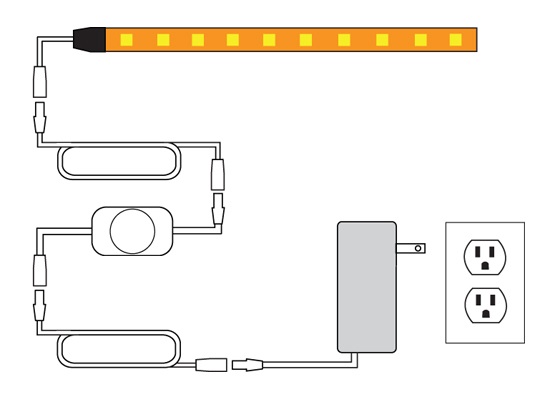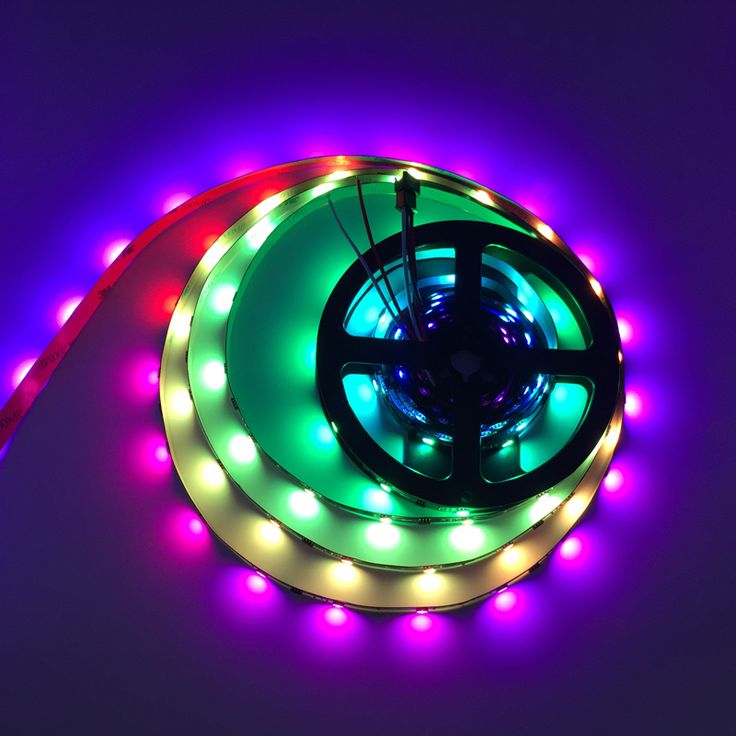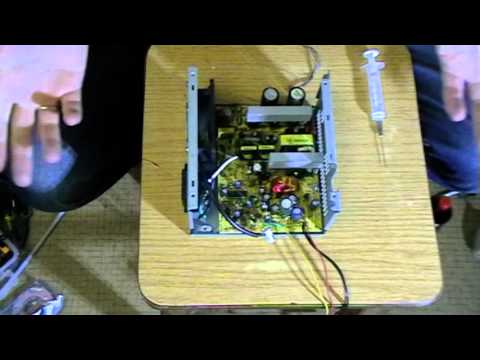In our century of rapidly developing technologies, LED strip has become a real find. She is economical, bright, beautiful, diverse. It remains only to figure out how to power the LED strip from all kinds of sources.
How to choose a tape
First you need to choose the right tape. An important factor when choosing is the purpose for which the backlight is set. Tapes vary depending on the number of bulbs located on one meter of tape. There are 30, 60, 120 and 240. The more light bulbs, the brighter the light.
Next, you need to determine the place where the tape will be located. Like any electric device, it is afraid of moisture. But there are several types of tapes adapted to the aggressive effects of the external environment. This can be found by reading the markings. IP20 is virtually unprotected. It should not be placed above the sink in the kitchen, in the bathroom or on the street. Rather, she will cover bookshelves or paintings in the interior. IP65 is sufficiently protected to work in the kitchen or in the bathroom. She also does an excellent job of lighting on the street. IP68 is an absolutely protected tape that can easily be used even for pool lighting.
For further operation of the tape, you need to understand what kind of backlight is needed - monochrome or multi-colored, warm or cold. And, of course, pay attention to the size of the illuminated surface. All this should be taken into account when deciding on the purpose of the tape.
number
There are a few more differences to keep in mind when choosing a tape. When connected to power sources, you will have to be guided by precisely these data. The bulbs located on the segment make the tape unique. For example, if only one LED is located on one segment, then the tape will be marked as follows: 5 V. If the LEDs are on segment 3, then this is a 12 V. tape. There is also a 24 V tape, which has 6 LEDs on a segment. Such tapes are very convenient, since they can be cut into pieces of almost any length. For 220 V tapes, a segment can be 1 meter, and 60 LEDs will be located on it. If there are 120 diodes on the meter, then the cutting step can be 50 cm. Their disadvantage is that you will have to purchase a tape, measuring the lengths of the meter, at least half a meter. The most common tapes on the market are 12 V and 220 V. As a rule, adapters are sold immediately from the tape bay. But if you need a small piece, you will have to purchase everything separately.
To solder or not to solder?
Starting to work with LED strip, you need to know that for its connection to the network, there are two ways to connect - solder and connector. Experts say that soldering a tape is much cheaper and more reliable than using plastic connectors to connect it. The connectors themselves are plastic clips with two contacts for single-color ribbons and four for multi-colored ones. Working with them is quite simple. It is better to use such a connection where it is not possible to solder the tape, or if it needs to be bent at an angle. Then come in handy corner connectors or with a bend. Nevertheless, it is better to arm yourself with a soldering iron and do it in a more reliable way.
To work, you will need the tape itself, a low-power soldering iron with a thin tip and an adjustable temperature regime, solder, rosin and double-sided tape, to which you can stick the tape and shrink tube during operation. We also need the devices necessary for connecting the tape to the power supply, namely the power supply unit, the wires for connecting the tape to the unit and the unit to the network, if necessary, a switch or socket.
Working with a soldering iron itself requires a certain skill, but you can also handle this if you wish. Begin by preparing a place to work. It should be a solid and even surface, protected from possible fire. Further attention should be paid to the soldering iron. If necessary, it must be cleaned, possibly using sandpaper or a metal brush. Carefully remove residual dirt with a sponge or rag. On the work surface you need to fix the tape so that it does not move during operation. Double-sided tape is useful for this, if there are no other devices for attaching parts. The tape must be cut at the indicated location where the scissors are shown. The wires need to be cleaned and freed from insulation, again slightly stripped with a knife. Determine where the “plus” and “minus” are located, and strictly observe the connection rule. Next, you need to strip the contacts on the tape and apply a thin layer of solder. The tape has paired contacts for connection, so the wires need to be soldered in two places, bending them at an angle of 90 ° in different directions. Further, the joints should be protected with a special heat-shrink tube. If rosin was used during soldering, then do not clean it, since it can also act as an insulation.
What can I power the LED strip from
When all the preliminary connecting work is completed, the LED strip must be powered by electric current. For this, the mains, batteries and batteries, as well as a computer power supply, are suitable. In some cases, the tape can be powered even from a telephone battery. Naturally, no matter what source you choose, you need to familiarize yourself with the intricacies of connecting an LED strip to it.
Mains connection

If you will use a home network, then it is worthwhile to study in detail how to power an LED strip from 220 Volts. As mentioned above, during installation, you will need a power supply. For such a tape, a power supply is not needed, but a special wire is needed, which will act as a diode bridge. When you figured out how to power an LED strip from 220 Volts, you need to take into account that other types of tape more than 5 meters will have to be powered not linearly, but in parallel. 220V LED strip is good in that it can be purchased immediately in a bay of 100 m or connected linearly to the desired length. Such long ribbons are needed for decorative illumination of houses or pools. If you need a piece of shorter length, you can simply cut it off at the site of the cut and put a protective plug. However, the lack of a power supply during installation of this tape can lead to some problems. Voltage drops will adversely affect diodes. This can lead to rapid burnout and decommissioning of entire sectors. In addition, it must be borne in mind that due to the lack of the same power supply in such tapes, flicker is observed, which sometimes is not able to catch the human eye, but it will adversely affect well-being. Therefore, 220 volt tapes are best placed on the facade of the house or as an illumination on the street during the New Year holidays. These tapes are insulated with silicone, which makes them indispensable in Russian weather conditions.
Batteries to help
If you need to illuminate a small area, then check out how to power the LED strip from the batteries. The principle of this method is not too different from all the previous ones. When connecting all the elements, remember the polarity and select the materials suitable for connecting with the selected tape. Batteries must have a total voltage of 12 volts. It can be any battery, even a little one or a tablet. Well, if it will be rechargeable. Then the problem of replacing the batteries will be replaced by timely recharging of the battery. Below is how to power the LED strip from batteries:
- First you need to clean the contacts well.
- Tin the ends of copper wires.
- Apply flux and solder the wires to the battery - red to plus, black to minus.
- Do the same with a button or toggle switch. Only through it pass only one wire (positive) and solder it to the input of the toggle switch. Launch the output on tape.
Battery connection
Now it’s clear how to power the LED strip. But what if the light is needed not at home, but, for example, outdoors in a tent? If the picnic lasts several days, not a single battery can withstand such a long period. Therefore, you need to think about how to power the LED strip from the battery. There are special batteries with capacities from 2 to 100 Ah, which can be used for such purposes. The difficulty can only be that special connections go to the battery, which again will have to be connected to the tape. By the way, if you decide the question of how to power a 12V LED strip, then this is exactly the case.
Computer connection

If you are still worried about the question of how to power the 12-volt LED strip, then you can recall the spare parts from the computer. This option is suitable for those who understand not only the connection of electrical elements, but also in electronics. It is knowledge in the hardware of the computer that can come in handy in this situation. Considering the question of how to power an LED strip, one can not help but recall that in our age there are much more opportunities than our parents have. It is impossible to imagine a single house without a computer. This raises a new question: is it possible to power the LED strip from the computer's power supply? With a little knowledge, anything is possible. A block from any old computer that had to be taken apart for reasons not related to a block malfunction is useful. All wires must be present in it. For this purpose, we need a yellow wire, which is powered by 12 watts, and black, which will perform the function of grounding. The remaining wires will not come in handy. More details about the process can be found thanks to the instructions presented in the video.

So, how to power the LED strip from 5 volts? You will not find such tapes in stores often, but if you set a goal, then you can actually get them on the Internet. As a rule, they are suitable for using wires with a USB output. And if for some reason the question arose, how to power the LED strip from USB, you need to do the following: solder the wire to the tape, then directly connect the USB connector to it, having previously cut it off, leaving at least 5 cm of cable at the end. Strip wires from both sides and connect, observing polarity. You can not solder and use ordinary electrical tape. This method is not designed for a long service, but can be useful as a temporary solution to the problem. Suitable as a mobile phone battery powered lighting.
Additional features
How else can LED strips be used? For example, if you correctly install the tapes in the cabinets, then you can not only decorate the house, but also make it more functional. On a shelf with clothes, on the steps of a ladder, above a sink in the kitchen, or as a highlight in a cupboard, a smart tape is suitable for all this. And although it has some disadvantages, at the moment it is the most economical of additional power sources. Long-term diode service, low electricity consumption, alternative power sources, mobility and appearance that do not spoil the interior of the room - all this speaks in favor of LED strips.
Simply and easily
So, having figured out how to power the LED strip, we conclude that if you have the desire and additional sources of information, it is quite possible to do it yourself. And if you recall that the installation of such lighting by the master will be about one and a half to two times more expensive than the materials themselves, then you should definitely try your hand at this, possibly, new business. Of course, you must follow safety precautions when working with electrical appliances.
Kit Options
When purchasing an LED strip, it may be worth paying attention to the ready-to-use fixtures. This is an easier way to light areas in your home. With some zeal, you can now find lighting for every taste and budget. In addition, sometimes assembly from separately purchased items can come out much more expensive than finished products. The tape itself can not give lighting without additional devices. For it, you should also purchase a power supply, adapter, adapter and a certain amount of wire with which it all connects. For a professional, this will not be difficult. But the amateur will have to write out all the required characteristics, draw a connection plan, assemble all the parts together, try not to mix up the wires and thus not destroy all the materials purchased. And the result may be far from intended.
At the same time, the master, collecting lighting, is able to control the quality of the material used, work on the installation of the structure and placement. If you want to become a true master and to decorate and ennoble your home as much as possible, you need to start with a small and simple one, gradually moving on to more complex elements.
In conclusion, it should be recalled that, when collecting more economical lighting, it is not worth buying cheap materials. As they say, avaricious pays twice, or even more. On the Internet, there are many offers from Chinese craftsmen. Just the absence of any guarantees, and sometimes labels, makes you wonder if their use will lead to a sharp decrease in the life of the device or to more irreparable problems in the form of accidental fire or damage to health. It is worth paying attention to the choice of not only the material itself, but also the manufacturer.